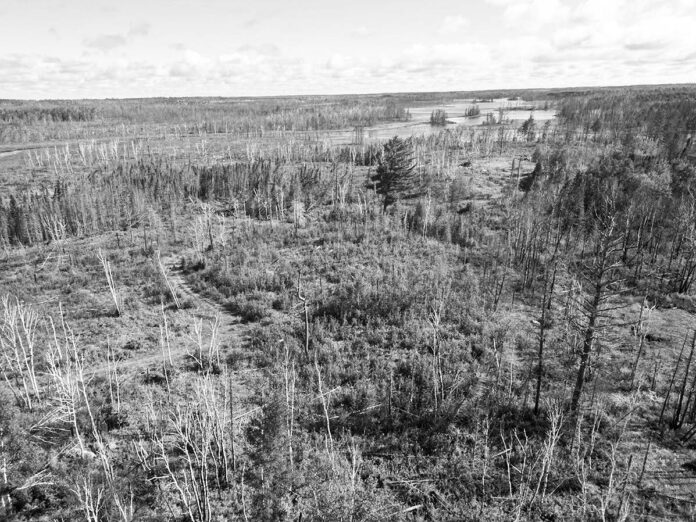The purchase is TNC’s largest land acquisition in Minnesota in 25 years and permanently protects forests, wetlands and connected wildlife habitat
MINNEAPOLIS, Minn. – The Nature Conservancy (TNC) has permanently protected 12,271 acres of forest and freshwater habitat north of Two Harbors— its largest land acquisition in Minnesota in a quarter century. The newly conserved land will be added to TNC’s adjacent 6,344-acre Sand Lake/Seven Beavers Preserve, nearly tripling its size.
The land features wetlands teeming with wildlife, winding rivers, clean lakes and vast forests, including some of the best peatland forests in the region, which are home to carnivorous plants and rare songbirds. It’s part of the Great Lakes Northwoods, a 60 million-acre region spanning Minnesota, Wisconsin and Michigan that’s recognized as a global priority by TNC for biodiversity and climate resilience.
“This was a remarkable opportunity to conserve a significant piece of Minnesota’s Northwoods forever and expand our Sand Lake/ Seven Beavers Preserve,” said Ann Mulholland, director of The Nature Conservancy in Minnesota, North Dakota and South Dakota. “By conserving the forests and waters here, we’re ensuring connected wildlife habitat, healthier forests, clean water and continued public access now, and for generations to come.”
The acquisition conserves eight and a half miles of shoreline, including part of the headwaters of the Rainy River, which flows into the Boundary Waters Canoe Area Wilderness, and the St. Louis River, which drains into Lake Superior. It also protects high-quality peatlands—unique, spongy wetlands that filter water, store immense amounts of carbon and provide habitat for rare species.
Iconic wildlife such as moose, lynx, gray wolves, black bears and migratory birds rely on these forests, lakes and rivers to survive. Declining songbirds like the boreal chickadee and Connecticut warbler depend on the unique peatland forest habitat, while the forests are home to great gray owls, northern goshawks, woodpeckers and more. Surrounded by a mosaic of conservation lands—including TNC’s existing Sand Lake/Seven Beavers Preserve, the Sand Lake Peatland Scientific and Natural Area, Finland State Forest and Superior National Forest—this property is now part of a network of more than 40,000 acres of connected habitat.
“This acquisition ensures wildlife can move freely across a resilient, protected network of lands,” said Rich Biske, director of land and water protection for TNC in Minnesota, North Dakota and South Dakota. “As climate change drives species to seek new habitat, connected lands like this are more important than ever. We’re proud to ensure this unique property remains intact and undeveloped for people and nature.”
The Nature Conservancy will restore forest and wetland habitat across the property using sustainable timber harvesting and tree planting, including in areas burned by the 2021 Greenwood Fire. The burned areas offer a unique opportunity to implement climate-smart restoration practices in an outdoor laboratory setting. TNC has already begun planting trees on nearby lands to encourage healthy, diverse forests that sequester and store more carbon.
In Minnesota, this is TNC’s largest forest acquisition to date and its largest land acquisition since 2000, when the organization purchased more than 24,000 acres to begin Glacial Ridge, the largest grassland and wetland restoration project in U.S. history, and now part of a national wildlife refuge.
The newly acquired land at Sand Lake/Seven Beavers Preserve will remain open to the public for hunting, fishing and recreation, though visitors should be aware that there are no developed trails or restrooms on the property. TNC will also be paying property taxes on the land.
Across the Northwoods, TNC is leading large-scale conservation efforts to protect the lands and waters that are critical to the health and well-being of both people and nature. In Minnesota, TNC is focused on protecting existing forests, planting millions of trees, reintroducing fire to fire-dependent forests through controlled burns, and advocating for forest-friendly policies and public funding.
To learn more about TNC’s work in Minnesota, visit nature.org/Minnesota.
The Nature Conservancy is a global conservation organization dedicated to conserving the lands and waters on which all life depends. Guided by science, we create innovative, on-the-ground solutions to our world’s toughest challenges so that nature and people can thrive together. The Nature Conservancy is working to make a lasting difference around the world in 83 countries and territories (39 by direct conservation impact and 44 through partners) through a collaborative approach that engages local communities, governments, the private sector, and other partners. To learn more, visit nature.org/Minnesota.


